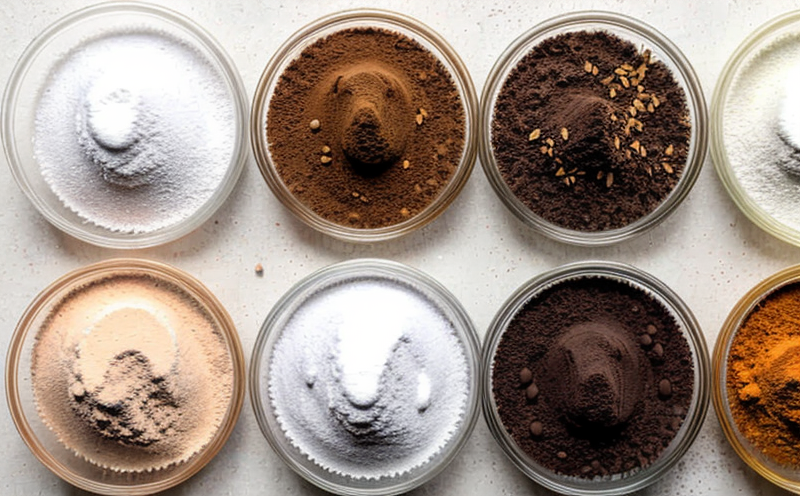FDA BAM Artificial Sweetener Detection in Beverages
The FDA’s Bacteriological Analytical Manual (BAM) is a comprehensive collection of methods designed to ensure food safety and quality. One specific test within this manual focuses on the detection of artificial sweeteners in beverages, which plays a crucial role in compliance with regulatory requirements set forth by the Food and Drug Administration (FDA).
Artificial sweeteners are widely used in various beverage formulations due to their zero or low-caloric content, making them attractive for health-conscious consumers. However, the presence of these compounds can pose challenges during quality control processes. The FDA BAM procedure offers a reliable method to detect artificial sweeteners, ensuring that products meet strict safety and labeling standards.
The test typically involves several steps, including sample preparation, extraction, and analysis using high-performance liquid chromatography (HPLC) or gas chromatography-mass spectrometry (GC-MS). These methods provide precise quantification of artificial sweetener concentrations in beverages. Compliance with these tests ensures that the products are safe for consumption and accurately labeled according to FDA guidelines.
Compliance with FDA BAM standards is essential not only for legal reasons but also to maintain consumer trust. By detecting artificial sweeteners, laboratories can ensure product quality and safety, thereby reducing the risk of health issues associated with non-compliant beverages.
The importance of this test cannot be overstated in today’s regulatory landscape. The FDA continuously updates its BAM methods to address emerging trends and concerns in food safety and quality. Laboratories that perform these tests must stay current with these updates to ensure accurate, reliable results.
Understanding the nuances of artificial sweeteners is critical for those involved in beverage production and quality control. These compounds are often used as sugar substitutes or flavor enhancers, but their presence can complicate analytical processes due to their diverse chemical structures. Laboratories must employ sophisticated techniques to differentiate between various types of artificial sweeteners effectively.
The FDA BAM test serves multiple purposes, including:
- Ensuring compliance with FDA labeling requirements
- Detecting the presence of artificial sweeteners in beverages accurately
- Providing data for product development and formulation adjustments
- Aiding in the detection and mitigation of potential contaminants
In summary, the FDA BAM test is a vital tool in the beverage industry. It ensures that products meet stringent safety standards while providing valuable insights into the composition of beverages. By leveraging this method, laboratories can contribute significantly to maintaining high-quality standards within the food and feed sector.
Benefits
Compliance with FDA BAM methods offers numerous advantages for businesses in the food and beverage industry:
- Regulatory Compliance: Ensures adherence to FDA labeling requirements, reducing legal risks associated with non-compliant products.
- Reduces the likelihood of product recalls due to mislabeling or contamination issues.
- Consumer Trust: Maintains consumer confidence by providing assurance that products are safe for consumption and accurately labeled.
- Enhances brand reputation and loyalty among health-conscious consumers.
- Product Quality: Provides insights into the composition of beverages, aiding in product development and formulation adjustments.
- Enables companies to optimize formulations for taste, texture, and nutritional content.
- Risk Mitigation: Detects potential contaminants or adulterants that could compromise the safety of beverages.
- Aids in early identification and mitigation of risks associated with unsafe products.
The FDA BAM test is a cornerstone of quality assurance and compliance for businesses operating within this sector. By ensuring accurate detection of artificial sweeteners, laboratories can help maintain the highest standards of safety and quality in the food and beverage industry.
Customer Impact and Satisfaction
The FDA BAM test has a significant impact on customer satisfaction and trust by ensuring that products meet stringent regulatory requirements. This test provides peace of mind to consumers, knowing that their beverages are safe for consumption and accurately labeled according to FDA guidelines.
For quality managers and compliance officers within the food and beverage industry, the results of this test serve as a critical tool in maintaining product safety and integrity. By ensuring accurate detection of artificial sweeteners, laboratories can help companies avoid costly recalls and legal issues associated with non-compliant products.
R&D engineers also benefit from FDA BAM testing by gaining valuable insights into the composition of beverages. This information is essential for optimizing formulations and developing new products that meet both regulatory requirements and consumer preferences.
For procurement teams, adherence to FDA BAM standards ensures a consistent supply chain. By ensuring that all ingredients and final products comply with these stringent methods, companies can avoid disruptions caused by non-compliant suppliers or products.
In summary, the FDA BAM test is not just a compliance requirement but also a tool for enhancing customer trust and satisfaction. It enables businesses to maintain high standards of safety and quality in their operations, ultimately benefiting both consumers and stakeholders within the industry.
International Acceptance and Recognition
The FDA BAM Artificial Sweetener Detection test is widely recognized internationally as a standard method for ensuring food safety and quality. This test has been adopted by various regulatory bodies around the world, including those in Europe and Asia, due to its reliability and accuracy.
In the European Union, the use of HPLC or GC-MS methods similar to those described in FDA BAM is encouraged for detecting artificial sweeteners in beverages. The European Standard (EN) often aligns with FDA guidelines, ensuring consistency in analytical methods across different regions.
Similarly, in Asia, regulatory agencies such as the China National Food and Drug Administration (CNFDA) and the Japan Ministry of Health, Labor, and Welfare (MHLW) have incorporated FDA BAM methods into their own testing protocols. This international recognition highlights the importance of FDA BAM standards in maintaining global food safety standards.
The widespread adoption of FDA BAM methods underscores their significance in ensuring that artificial sweeteners are detected accurately and reliably across different markets. By adhering to these internationally recognized standards, laboratories can ensure consistent and accurate results, thereby enhancing trust and compliance within the industry.





